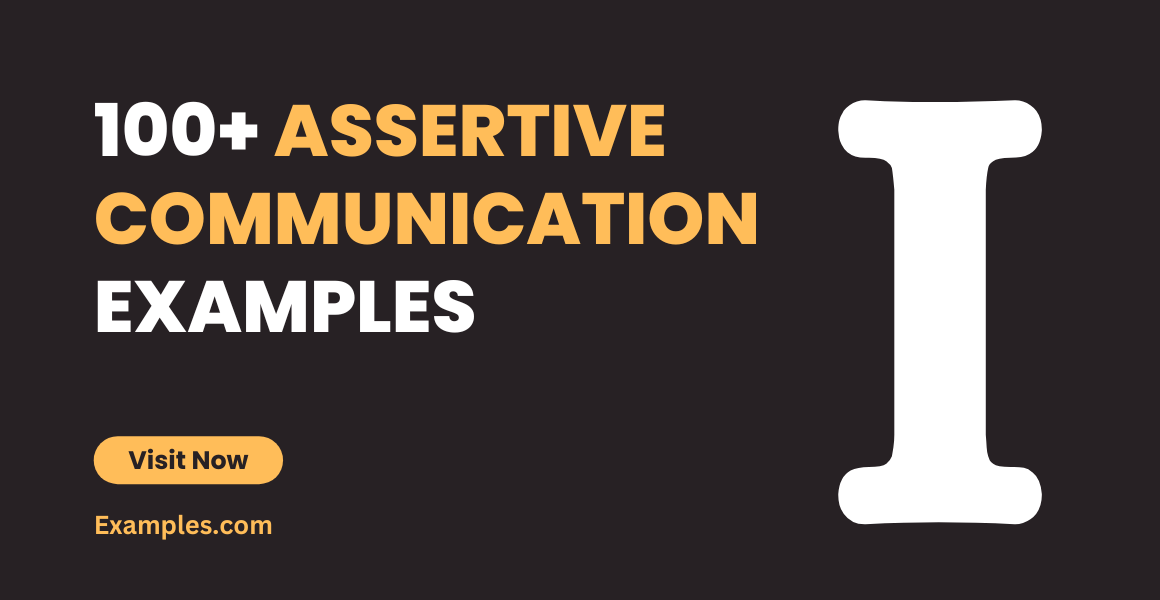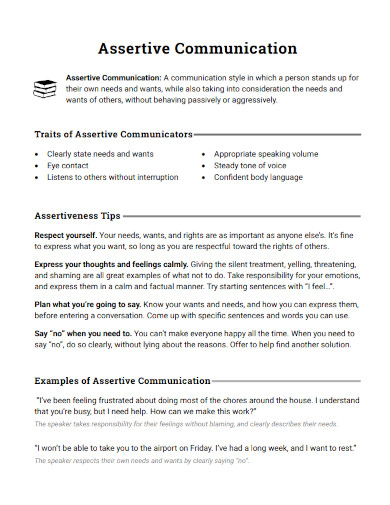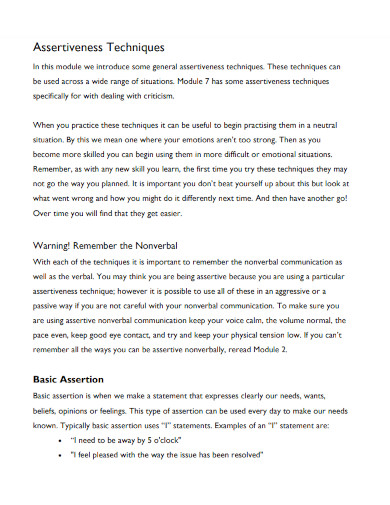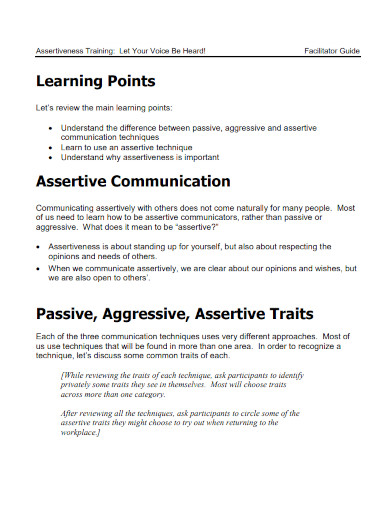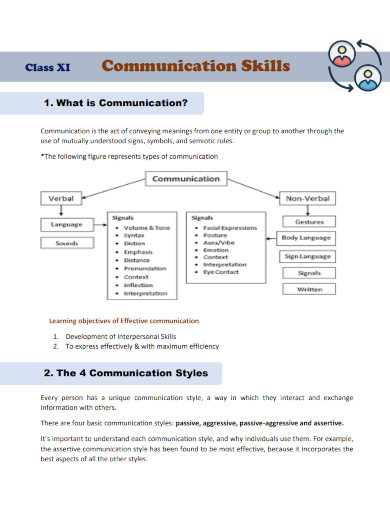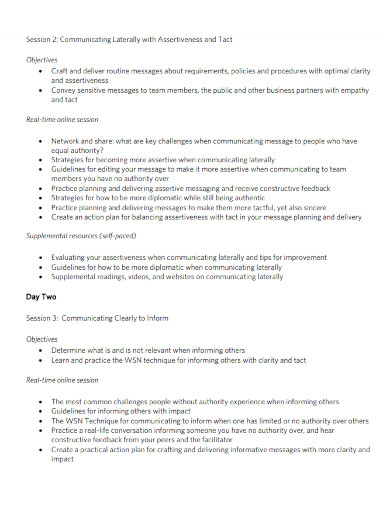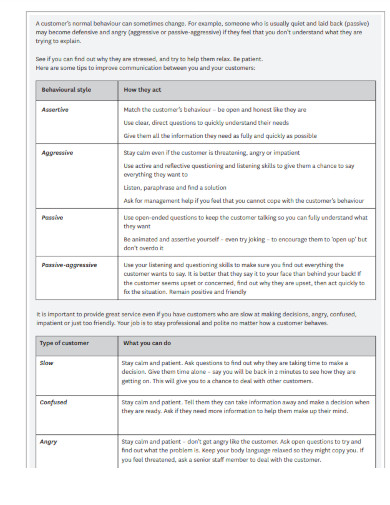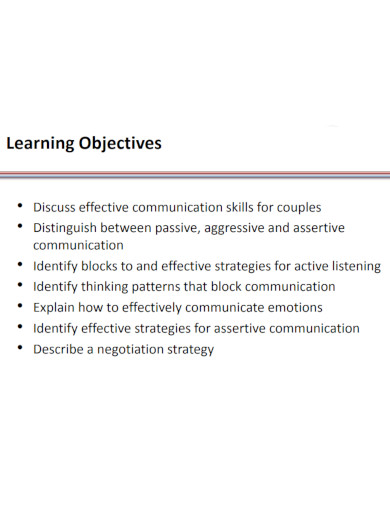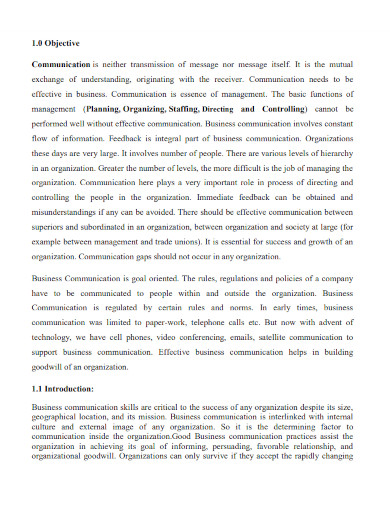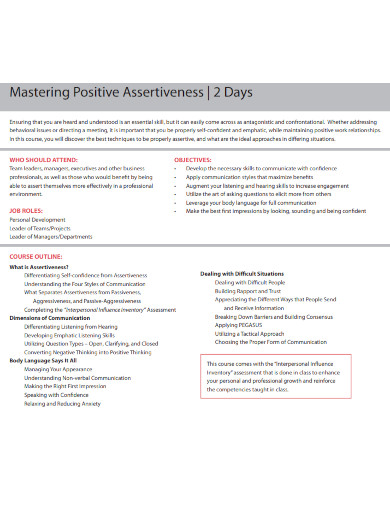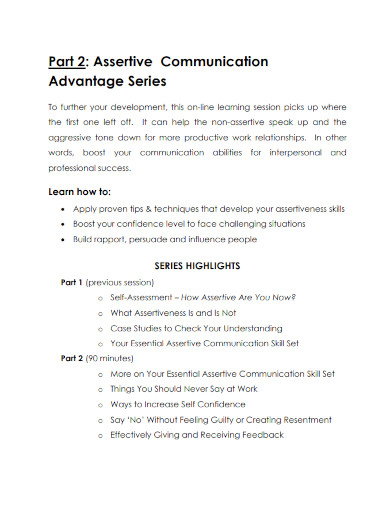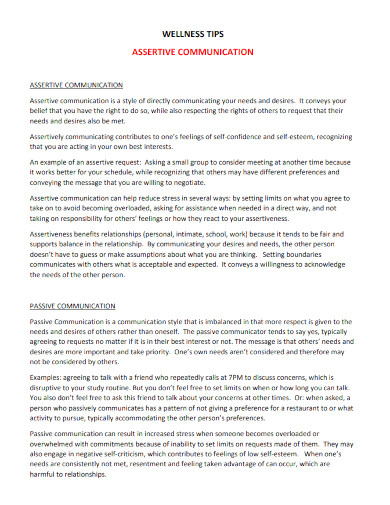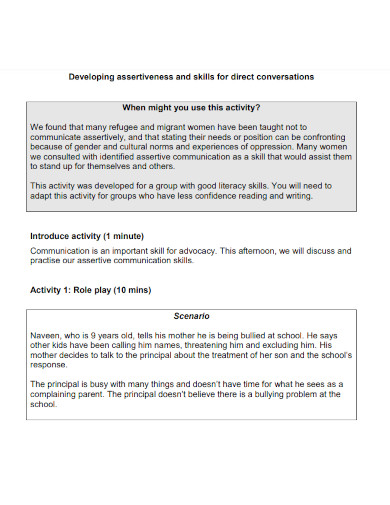100+ Assertive Communication Examples
When talking with other people, your eyes unconsciously take note of different non-verbal cues to comprehend the person’s intention. Not only that, but our ears will also absorb and take note of the other person’s intonation and words.
What Is Assertive Communication? – Definition
Communication is a very complex process that involves multiple parties bringing their points across. While communication style is the way a specific person communicates through a mix of verbal, and non-verbal communication. These styles are split into three categories which are passive, assertive, and aggressive communication styles. The assertive communication style is the in-between between passive and aggressive communication style that takes the best between the two other styles.
What is the Best Example of Assertive Communication?
Assertive communication is best exemplified in scenarios where an individual manages to express their needs, desires, or feelings clearly and directly, while still respecting the boundaries and rights of others involved. An ideal example of assertive communication can occur in a workplace setting.
Imagine a team member, Alex, who has been consistently staying late to complete projects due to an overwhelming workload. Alex decides to speak with the manager to address the situation assertively. Here’s how the conversation unfolds:
Alex requests a private meeting with the manager, ensuring there will be time to discuss the matter without interruption. During the meeting, Alex maintains steady eye contact, a relaxed but upright posture, and uses open hand gestures to convey a sense of honesty and engagement.
Alex begins the conversation with, “I’ve noticed I’ve been regularly working overtime to meet project deadlines. I’m committed to delivering quality work, but I believe my current workload is more than I can manage effectively in a regular workweek.” This statement clearly articulates the issue without placing blame on the manager or the team.
Alex continues, “I would like us to explore potential solutions together. Perhaps we could prioritize tasks more effectively or redistribute some responsibilities among the team. I’m confident that with some adjustments, I can continue contributing to our projects without consistently extending my work hours.”
In this example, Alex is using “I” statements to express personal feelings and is not accusing or demanding but rather inviting collaboration to find a solution. This approach demonstrates respect for the manager’s position while also highlighting Alex’s needs.
The manager, recognizing Alex’s assertiveness and willingness to find a workable solution, feels respected and is more inclined to respond positively. They work together to adjust Alex’s workload, benefiting both the team’s efficiency and Alex’s work-life balance.
This scenario encapsulates the essence of assertive communication: it is respectful, solution-focused, and acknowledges the needs of all parties involved. It leads to a constructive outcome without conflict or resentment, epitomizing effective interpersonal communication.
100 Assertive Communication Examples
Assertive communication is the art of expressing one’s opinions and needs confidently and respectfully. Mastering this skill fosters healthy relationships and creates a positive, productive environment. Our guide offers 100 unique assertive communication examples, each crafted to illustrate how to convey your message with clarity and confidence while maintaining a collaborative and respectful tone.
- Expressing an Opinion: “I believe that our team meetings could be more efficient if we set a clear agenda beforehand.”
- Saying No: “I appreciate your offer, but I won’t be able to participate in the event this weekend.”
- Setting Boundaries: “I enjoy our chats, but I need to focus on my work without interruptions during office hours.”
- Requesting Assistance: “Could you please help me with this report? Your expertise would be invaluable.”
- Declining Additional Work: “I’m currently at capacity with projects, so I won’t be able to take on extra tasks this month.”
- Seeking Clarification: “I’m not clear on what you mean by ‘immediate action’. Could you define that timeframe?”
- Feedback on Work: “I noticed a few errors in the report, and I suggest we review it together to ensure accuracy.”
- Addressing Misconduct: “I felt disrespected when you interrupted me in the meeting, and I’d like to discuss how we can communicate more effectively.”
- Asking for a Raise: “Given my contributions and achievements over the past year, I would like to discuss the possibility of a salary increase.”
- Negotiating Deadlines: “The deadline for this project is quite tight. Can we negotiate a more realistic timeline?”
- Disagreeing Politely: “I see your point, but I have a different perspective on this issue.”
- Sharing Concerns: “I’m concerned about how the new policy might impact our workflow. Can we explore this further?”
- Discussing Performance Reviews: “I would like to understand the specific areas you believe I need to improve on.”
- Expressing Personal Needs: “To maintain a healthy work-life balance, I need to stick to my agreed working hours.”
- Requesting a Deadline Extension: “Due to unforeseen circumstances, I’ll need an extension on this project to ensure the quality of work.”
- Navigating Interruptions: “I’d like to finish my point before we move on to the next topic.”
- Offering Alternatives: “If this approach doesn’t work, I have some alternative solutions that might meet our needs.”
- Challenging Decisions: “I understand the decision made, but I’d like to revisit the rationale behind it.”
- Confronting Issues: “There seems to be a misunderstanding, and I think it’s important that we clear it up.”
- Initiating Difficult Conversations: “I need to discuss something with you that may be sensitive. When would be a good time for you?”
- Reaffirming Understanding: “Let’s ensure we’re on the same page. You’re suggesting we delay the launch, correct?”
- Addressing Workplace Gossip: “I don’t feel comfortable discussing our colleagues in their absence. Let’s focus on the task at hand.”
- Handling Criticism: “I appreciate your feedback. I will reflect on these points and see how I can improve.”
- Proposing a Compromise: “I understand we have different preferences, so let’s find a middle ground that works for both of us.”
- Expressing Appreciation: “I really value the extra effort you’ve put into this project. It has not gone unnoticed.”
- Making Requests: “Could you please send me the data by Tuesday so I have enough time to analyze it?”
- Rejecting Inappropriate Requests: “I’m not comfortable with doing that task as it falls outside my professional responsibilities.”
- Standing Up for Others: “I believe everyone deserves a chance to express their ideas without interruption.”
- Managing Personal Space: “I need some space right now to process things. Let’s talk in an hour.”
- Clarifying Misunderstandings: “There seems to be a mix-up. What I meant to say was…”
- Resolving Conflicts: “We’ve hit a roadblock here, but I’m sure we can work together to find a resolution.”
- Asserting Presence in a Discussion: “I have some thoughts on this matter I’d like to share.”
- Responding to Change: “This change affects my current workload. How can we adjust to accommodate this new direction?”
- Expressing Discomfort: “This conversation is moving in a direction I’m not comfortable with. Can we steer back to the main topic?”
- Providing Constructive Feedback: “Your presentation was very informative. I think it could be even more engaging with some interactive elements.”
- Acknowledging Mistakes: “I realize I missed the mark on that project, and I’m taking steps to ensure it doesn’t happen again.”
- Asking for Time to Think: “I need some time to think this over before I give you an answer. Can we revisit this tomorrow?”
- Requesting Fair Treatment: “I feel that my work isn’t being evaluated on the same criteria as my peers. Can we discuss this?”
- Inquiring About Promotions: “I’m interested in advancing my career. What steps would you recommend I take to qualify for a promotion?”
- Balancing Conversations: “I’ve noticed I’ve been dominating this conversation. I’d like to hear your thoughts.”
- Advocating for Team Recognition: “The team has worked hard on this project and I think their efforts should be formally recognized.”
- Discussing Sensitive Issues: “This topic is sensitive, so let’s approach it with the care and attention it deserves.”
- Redirecting Off-Topic Discussions: “That’s an interesting point, but let’s keep our focus on the current agenda item.”
- Refusing Unreasonable Deadlines: “Given the project’s scope, the deadline proposed isn’t reasonable. Let’s discuss a feasible timeline.”
- Requesting Feedback: “I would like to receive feedback on my performance so I can continue to grow professionally.”
- Asserting Expertise: “I have extensive experience in this area, and I’d like to suggest a strategy that I believe will be effective.”
- Suggesting Improvements: “I’ve noticed a few areas for improvement that could significantly enhance our process.”
- Negotiating Salary: “Based on my research and contributions, I would like to negotiate my starting salary to align with industry standards.”
- Deflecting Personal Questions: “I prefer to keep the focus on professional topics during work hours.”
- Managing Disagreements: “I respect your viewpoint, but I see things differently. Let’s find a solution that satisfies both parties.”
- Prioritizing Self-Care: “To maintain my health and productivity, I will be taking a lunch break daily to recharge.”
- Declining Overwork: “I understand the urgency, but working consecutive weekends is not sustainable for me. Let’s discuss how we can manage this.”
- Revisiting a Decision: “I’ve given it some thought and would like to revisit our earlier decision based on new information I’ve received.”
- Addressing Unmet Expectations: “The support I was promised for this project has not been forthcoming. Can we address this issue?”
- Sharing a Different Perspective: “I hear what you’re saying, but here’s another perspective we might consider.”
- Establishing Availability: “I am available for meetings every weekday afternoon. Please schedule discussions within this time frame.”
- Correcting Inaccurate Information: “There seems to be a misunderstanding. Here are the facts that I can provide.”
- Offering Assistance: “You seem overwhelmed with that task. I have some time today to help if you need it.”
- Requesting Respectful Communication: “I am open to constructive criticism, but I expect that it will be delivered respectfully.”
- Highlighting Strengths: “I believe my strengths in strategic planning will be beneficial in leading this project.”
- Voicing Discomfort with Jokes: “I know you meant that as a joke, but it made me uncomfortable. Please refrain from such comments in the future.”
- Asking for Clarification in Miscommunication: “I’m not sure I fully understand your point. Could you please clarify?”
- Reiterating a Point: “As previously mentioned, my current focus is on completing the existing project.”
- Seeking Role Clarification: “I would like clarity on my role in this project to ensure I meet expectations.”
- Expressing Eagerness to Learn: “I am eager to learn more about this topic. Could you recommend some resources?”
- Addressing Procrastination: “Let’s not delay this task any further. I suggest we tackle it first thing tomorrow morning.”
- Clarifying Work-Life Balance Needs: “It’s important for me to maintain a work-life balance, so I’ll be logging off by 6 PM most days.”
- Resolving Resource Allocation: “Our team seems to have fewer resources compared to others. Can we discuss how to rectify this?”
- Discussing Personal Development: “I’m interested in developing my skills in X area. Can we discuss a plan for my development?”
- Managing Unwanted Advice: “I value your input, but I would like to try handling this on my own.”
- Suggesting Meeting Agendas: “I think our meetings would be more productive if we had a set agenda. Shall we start planning one?”
- Requesting Time Off: “I will be taking my annual leave next month. Let’s plan accordingly so that my absence doesn’t impact the team.”
- Discussing Office Etiquette: “I believe our office environment would benefit from a quiet policy for focus time. Can we implement this?”
- Refusing Gossip: “I’m not comfortable discussing our colleague’s personal life. Let’s focus on work-related topics.”
- Encouraging Team Input: “I’d love to hear everyone’s ideas on this matter. Let’s make sure all voices are heard.”
- Challenging Unfair Treatment: “I feel that I’m being treated differently than my peers. Can we talk about why that might be?”
- Navigating Difficult Conversations: “This is a difficult topic, but it’s important we address it directly and find a solution.”
- Expressing Gratitude: “Thank you for your hard work on this project. Your dedication is greatly appreciated.”
- Requesting Professional Development: “I would like to attend a training session on X to improve my skill set. Can we discuss this possibility?”
- Sharing Visions and Goals: “I envision our team achieving X in the next year. Let’s work together to make this a reality.”
- Discussing Performance Feedback: “I’d like to discuss my latest performance review and understand areas where I can improve.”
- Articulating Project Vision: “My vision for this project is X. Let’s collaborate to bring this to fruition.”
- Addressing Overcommitment: “I’m currently overcommitted and need to reassess my workload. Can we prioritize my tasks?”
- Handling Interruptions: “I would like to finish my current task before addressing new ones. Please allow me some time to complete it.”
- Discussing Team Dynamics: “Let’s discuss how we can improve our team dynamics and work more cohesively.”
- Asserting Expert Opinion: “Based on my experience in X, I recommend that we proceed with Y strategy.”
- Delegating Tasks: “In order to meet our deadline, I’m delegating X tasks to team members with the relevant skills.”
- Addressing Burnout: “I’m starting to feel burnt out and believe it’s affecting my work. Can we discuss ways to alleviate this?”
- Proposing Solutions: “I’ve identified a potential issue with X, and I propose Y as a solution. What are your thoughts?”
- Clarifying Expectations: “Let’s clarify our expectations to ensure we are aligned on the project’s objectives.”
- Navigating Misaligned Goals: “It seems our goals for this project aren’t aligned. Let’s revisit our objectives to ensure we’re working towards the same end.”
- Expressing Work Preferences: “I work best in a quiet environment. Could we consider a quiet hours policy in the office?”
- Initiating Role Discussions: “I believe my skills could be better utilized in a different role. Can we explore this possibility?”
- Confronting Delays: “This task has been delayed several times. Let’s address the cause and find a way to move forward.”
- Setting Meeting Parameters: “To keep meetings concise, I propose we limit them to 30 minutes and focus on key points.”
- Expressing Concern for Others: “I’m concerned about the well-being of our team during this busy period. Can we discuss support strategies?”
- Seeking Role Enhancement: “I’m interested in enhancing my role with more responsibilities. Can we discuss a plan for this transition?”
- Conveying Decision-Making: “After careful consideration, I’ve decided to X. I believe this is the best course of action for Y reasons.”
- Advocating for Equality: “I believe there is room for improvement in ensuring equality within our team. Let’s discuss actionable steps.”
- Expressing Passion: “I’m passionate about X aspect of my job and would like to focus more on this area. Can we discuss how this can be incorporated into my role?”
Assertive Situation and Communication Examples
Assertive communication is pivotal in navigating personal and professional landscapes. It’s a respectful articulation of one’s thoughts and feelings without undermining others. From resolving conflicts to setting boundaries, assertive dialogue promotes understanding and cooperation. This guide exemplifies assertive communication in various situations, providing real-life examples and explanations to empower readers with the tools for effective self-expression.
- Professional Feedback: “I value your insight, but I believe my approach aligns more closely with the project’s goals. Let’s find a way to merge our ideas for the project’s success.”Explanation: This statement respects the other person’s contribution while firmly presenting one’s own point of view.
- Declining Unwanted Tasks: “While I’m flattered by the offer, I cannot commit to chairing the committee due to my current workload. However, I’m happy to contribute in other ways.”Explanation: Here, the speaker politely declines an additional responsibility, offering an alternative form of assistance.
- Addressing Personal Boundaries: “I enjoy our catch-ups, but I need some quiet time during lunch to decompress. Would it be okay if we limit our chats to coffee breaks?”Explanation: The speaker is setting a personal boundary regarding their time in a friendly yet clear manner.
- Negotiating Workload: “I’ve noticed my workload has increased significantly. Could we discuss prioritizing my tasks or delegating some of the load to balance it more fairly?”Explanation: This is an assertive approach to managing workload by initiating a discussion on fair distribution of tasks.
- Handling Lateness: “When our meetings start late, it disrupts my schedule. Can we agree on starting on time or rescheduling if there’s a delay?”Explanation: The speaker is addressing the issue of punctuality and proposing a solution while expressing the impact of the problem.
Each example demonstrates the effectiveness of assertive communication in everyday scenarios, providing a clear framework for asserting oneself while maintaining professional and personal relationships.
1. Assertive Communication Template
2. Sample Assertive Communication
3. Assertive Communication Techinques
4. Assertive Communication Styles
5. Assertiveness Communication Training
6. Assertiveness Communication Skills
7. Assertiveness Communicating without Authority
8. Assertive Communication Customer Behavioural Styles
9. Effective Assertive Communication Skills for Couples
10. Assertive Communication Guide for Women
11. Assertive Communication Thesis Template
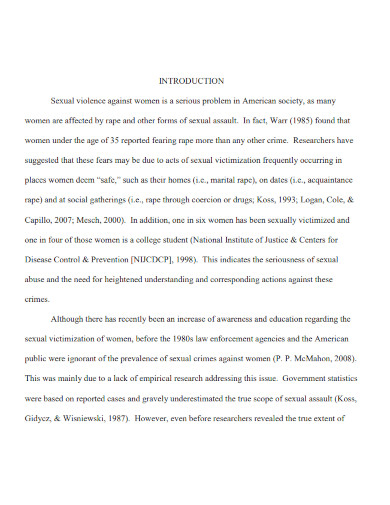
scholars.indstate.edu
12. Assertive Business Communication
13. Mastering Positive Assertiveness Communication
14. Assertive Communication Course Outline Template
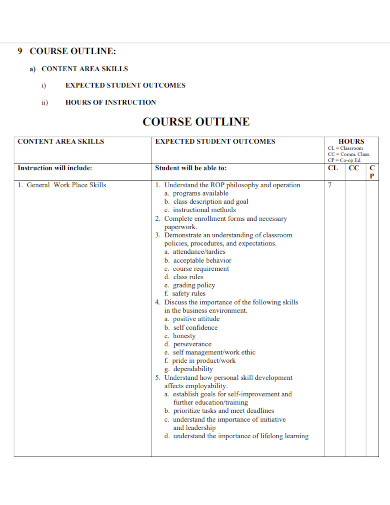
salinasuhsd.org
15. Assertive Communication Advantage Series
16. Assertive Communication Wellness Tips
17. Developing Assertive Communication Skills
How to Practice Assertive Communication Style
The assertive communication style allows the person to have and keep healthy relationships with other people. This is because the assertive communication style allows people to respect other opinions while standing up for themselves. But the person will need to have assertive communication training to be able to perfectly communicate in a healthy way.
1.) Assess your Current Communication Style
Begin by assessing or taking note of what type of communication style you take. You could start by asking yourself and other people how you communicate and the way you make them feel. If they often feel like you communicate oppressively, then you may have an aggressive communication style. If you feel like your opinion or your stance is often put down, then you may have a passive communication style.
2.) Practice Telling Other People No or Yes
If you have an aggressive or aggressive-leaning communication style, you must practice telling other people yes to their thoughts, and respecting their opinion. But if you have a passive or a passive-leaning communication style, then you must practice telling other people no, and communicating your thoughts and feelings to the other party.
3.) Take Note of Your Emotions
You must take notes or journal the emotions you feel when you communicate with other people. This is because communication is a two-way street, meaning both parties will have specific feelings that they will feel. Doing this will help you catch your emotions and keep them in check.
4.) Practice Posture and Non-Verbal Communication
Assertive communication is not limited to just verbal communication. You will need to practice your posture and other non-verbal cues that will help both you and the other party relax.
Passive vs. Assertive Communication Style
| Aspect | Passive Communication Style | Assertive Communication Style |
|---|---|---|
| Definition | Passive communication is a style where individuals avoid expressing their opinions or feelings, protect their rights, and identify and meet their needs. | Assertive communication is a style in which individuals clearly state their opinions and feelings, and firmly advocate for their rights and needs without violating the rights of others. |
| Characteristics | Avoids conflict, struggles to say no, allows others to infringe on personal rights, often results in being overlooked. | Open, honest, respects self and others, direct but not insulting, maintains self-control. |
| Body Language | Avoids eye contact, has a slouched posture, and often appears withdrawn or disconnected. | Maintains good eye contact, stands straight, appears relaxed but confident. |
| Outcome | May lead to a buildup of unspoken resentment, personal frustration, and potential loss of self-esteem. | Results in respect from others, enhanced self-confidence, and satisfaction from clear, concise communication. |
| Effectiveness | Generally ineffective as it doesn’t communicate the individual’s needs or feelings adequately. | Highly effective as it conveys messages in a respectful and inoffensive manner. |
Assertive Communication Techniques
Assertive communication is a skill that combines clarity and confidence with respect and empathy. To convey your message assertively, consider these techniques:
- Use “I” Statements: Frame your sentences from your perspective to avoid sounding accusatory. For example, “I feel concerned when…”
- Maintain Eye Contact: Establishing eye contact conveys confidence and sincerity.
- Control Your Emotions: Stay calm and composed, even if the topic is emotionally charged.
- Practice Active Listening: Show that you value others’ opinions by listening without interrupting.
- Keep Your Tone Even and Clear: Use a steady voice to express your message firmly and calmly.
- Use Nonverbal Cues: Body language should align with your words; no crossed arms, but open gestures.
- Be Direct and Specific: Clearly state what you need, feel, or believe without being vague.
- Express Empathy: Acknowledge the feelings and needs of others in the conversation.
- Stay Solution-Focused: Focus on finding solutions rather than dwelling on problems.
- Set Boundaries: Know and communicate your limits respectfully.
These techniques, when used consistently, can enhance assertiveness in communication, ensuring that your message is heard and respected.
Characteristics of Assertive Communication
Assertive communication is identifiable by several key characteristics:
- Honesty: Assertive communicators are truthful without being hurtful.
- Respect: They show respect for themselves and others, ensuring a balanced interaction.
- Confidence: They communicate with confidence, asserting their presence and ideas.
- Fairness: Assertiveness is about fairness, striving for win-win outcomes.
- Responsiveness: They are responsive to the needs and boundaries of others.
- Non-Threatening: Their communication is firm but not aggressive or imposing.
- Open to Feedback: Assertive individuals are open to constructive criticism and feedback.
- Responsibility: They take responsibility for their choices and the consequences.
- Empathy: There is a strong sense of empathy and understanding in their communication.
- Consistency: They are consistent in their use of assertive communication, regardless of the situation or audience.
These characteristics are the hallmark of an individual who communicates assertively, leading to more effective and fulfilling interactions.
Why is Assertive Communication Important?
Assertive communication is crucial for several reasons:
- Enhances Relationships: It fosters respect and understanding in personal and professional relationships.
- Promotes Self-Esteem: Being heard and respected boosts self-esteem and confidence.
- Improves Decision-Making: Clear, assertive expression contributes to better decision-making and leadership.
- Reduces Stress: Assertiveness can reduce stress from unspoken issues or aggression.
- Encourages Honesty: It creates an environment where people feel safe to speak honestly.
- Resolves Conflicts: Assertive communication is key in resolving conflicts effectively.
- Facilitates Career Advancement: It is often associated with strong leadership and can lead to career growth.
- Supports Personal Integrity: Assertiveness allows you to stand by your values and beliefs.
- Improves Problem-Solving: It helps to address problems head-on rather than avoiding them.
- Encourages Mutual Respect: Assertive communication promotes a culture of mutual respect.
Understanding the importance of assertive communication can lead to more positive interactions and a more assertive approach to life and work.
Which Statement is an Example of Assertive Communication?
Assertive communication is characterized by directness and honesty while being respectful and non-confrontational. An example of an assertive statement is:
“I feel undervalued when my work is not acknowledged. I would like us to discuss possible ways for my contributions to be recognized.”
This statement is assertive because:
- It begins with “I feel,” which expresses the speaker’s emotions without blaming the listener.
- It states the problem clearly – feeling undervalued due to lack of acknowledgment.
- It invites collaboration by asking to discuss recognition methods, rather than demanding or complaining.
Such statements promote open dialogue, respect personal boundaries, and lead to constructive solutions, encapsulating the essence of assertive communication.
What Does Assertive Communication Look Like?
Assertive communication manifests through both verbal and nonverbal cues that convey respect for oneself and others. It typically involves:
- Clear and Concise Language: Conveying messages in a straightforward and understandable way without being overly verbose or ambiguous.
- Confident Vocal Tone: Speaking with a firm yet calm tone that reflects confidence without aggression or passivity.
- Appropriate Volume: Using a volume loud enough to be heard clearly, which signifies self-assurance, but not so loud as to intimidate.
- Respectful Word Choice: Choosing words that are respectful and avoid demeaning others, focusing on the message rather than personal attacks.
- Positive Body Language: Maintaining an open posture, steady eye contact, and relaxed facial expressions to reinforce the spoken message.
- Active Listening: Demonstrating attentiveness to the speaker through nodding and acknowledging their points, showing that their input is valued.
- Constructive Feedback: Offering feedback that is helpful and aimed at improvement rather than criticism for its own sake.
- Emotional Control: Managing emotions effectively to stay composed, even in challenging or stressful interactions.
Assertive communication is about balance, ensuring that one’s own needs are expressed while also being considerate of others’ perspectives. It is an empowering communication style that facilitates mutual respect and understanding.
How do you Use Assertive Communication? – Step by Step Guide
- Understand Your Rights: Acknowledge that you have the right to express your thoughts, beliefs, and emotions.
- Identify Your Needs: Clearly define what you need to communicate. Knowing your objective can guide your approach.
- Choose the Right Time: Find a suitable time to have the conversation. This ensures that both parties are receptive.
- Use “I” Statements: Start sentences with “I” to express your thoughts and feelings without blaming the other person (e.g., “I feel…” instead of “You make me feel…”).
- Practice Active Listening: Pay attention to the other person’s response. Listening is as important as speaking in assertive communication.
- Maintain Eye Contact: Look at the person you are speaking to. This shows confidence and sincerity.
- Keep Your Emotions in Check: Stay calm and composed, even if the conversation becomes challenging.
- Be Specific and Clear: Avoid vague statements. Be clear about what you want to say.
- Respect Others’ Rights: While being assertive, be respectful of the rights and feelings of others.
- Practice and Reflect: After the interaction, reflect on what went well and what could be improved. Practice regularly.
Tips for Improving Assertive Communication
- Build Self-Esteem: Confidence is key to assertiveness. Work on feeling good about yourself and your right to express your opinions.
- Use Assertive Body Language: Stand tall, make eye contact, and use firm but pleasant facial expressions.
- Stay Calm: Take deep breaths if you start to feel emotional. Keeping calm will help you maintain clarity and focus.
- Rehearse: If you’re preparing for a difficult conversation, practice what you want to say beforehand.
- Learn to Say No: You have the right to set boundaries. Practice saying no in a firm but polite way.
- Empathize: Try to understand the other person’s point of view, which can help you respond assertively rather than reactively.
- Express Positive and Negative Feelings: Be open about your feelings and concerns, but also share positive feedback.
- Use Humor: A light-hearted approach can ease tension, as long as it’s appropriate and doesn’t undermine your message.
- Seek Feedback: Ask for input from trusted friends or colleagues on your communication style.
- Attend Workshops or Therapy: Consider professional development opportunities to improve your assertive communication skills.
Optimized for “Assertive Communication,” this guide offers valuable insights into adopting an assertive style, enhancing interpersonal interactions, and fostering a balanced dialogue in various scenarios.


